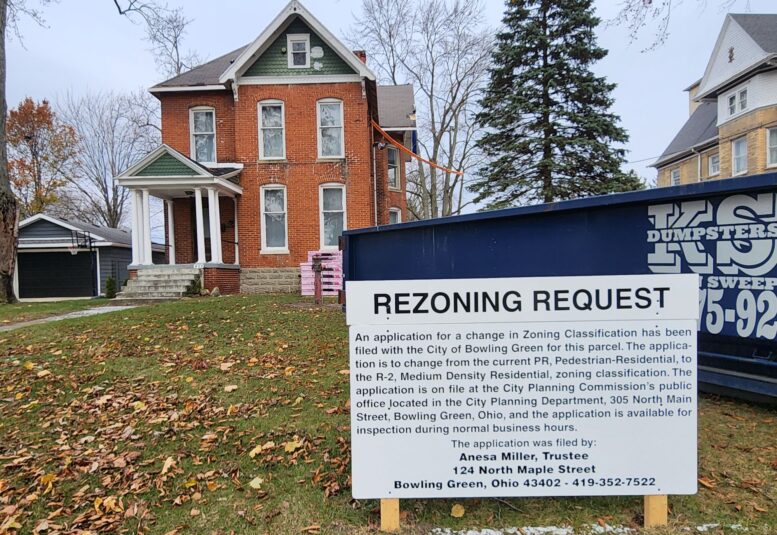By JAN McLAUGHLIN
BG Independent News
In order to preserve one of the oldest buildings on West Wooster Street, the new owner has asked to turn it into a duplex.
Bowling Green Planning Commission will hold a public hearing on Jan. 15, at 7 p.m., on a request to rezone 416 W. Wooster St. so it can become a duplex. The zoning request will then be heard by City Council in late February or early March.
The owner, Anesa Miller, has asked that the zoning be changed from PR Pedestrian Residential to R-2 Medium Density Residential.
Miller purchased the property in 2023 hoping to donate it to a non-profit organization willing to renovate it for a public purpose. However, that failed and she is now exploring possibilities of saving the historic site by renovating the building as a two-family rental.
Some neighbors question the precedent set if the city approves the change. City Council could be hard pressed to turn down similar requests from owners noting the hardships of maintaining old buildings.
And while Miller may be trusted to maintain the property as a duplex, the zoning classification stays with the property whenever the location transfers to new owners.
The building, which began as a home-hospital, was selected as an historic building of the month earlier this year by the BG Historic Preservation Commission.
Although the building needs many renovations and repairs, several essential features remain intact. There are two original stairways and one ornate banister. There is an original fireplace and four sets of pocket doors, as well as original moldings. The foundation and masonry walls are sound, according to the story.
The Historic Building of the Month story, researched by Geoff Howes, of the Bowling Green Historic Preservation Commission, noted the value of the home/hospital.
“The Manville House, part of the Boomtown Historic District placed on the National Register of Historic Places in 1987 and part of the living history of this town, is in danger of being torn down if funding and a new purpose are not found for it,” the story stated.
However, the solution being proposed is problematic since it would require the city to change the zoning for the property from the newly adopted Pedestrian Residential zoning. At the insistence of citizens wanting to protect the neighborhoods and older housing in the blocks surrounding downtown, this zoning does not allow duplexes.
Miller, the owner of the historic home, spoke out at council meetings against duplexes in older neighborhoods that are already populated with a lot of rental housing. “We don’t want more duplexes than we already have,” she said at a meeting in 2023.
During a zoning meeting in the fall of 2022, Miller talked about her concerns that more owner-occupied homes will become rentals. “I do see some deterioration in my neighborhood,” as more houses transition to rental properties, she said.
And in a letter during the zoning discussions in 2023, Miller wrote of her concerns about older homes being converted to rentals if the city allowed houses to be divided in older neighborhoods.
“Maintaining older homes requires ongoing investment, something us ‘older residents’ have been doing for decades. But our houses could quickly be turned to profit if you lower your standards, slap up some drywall, and divide that aging edifice into a duplex, triplex, or apartment building,” she wrote.
According to Howes’ research, the structure at 416 W. Wooster St. is likely the oldest building still standing on the street.
Bowling Green physician and pharmacist Dr. Andrew J. Manville built the red brick building as his family home in the 1860s or 1870s. As was customary in that era, Manville saw patients in a specially equipped part of the house.
Manville, a successful farmer, was encouraged by his mother to study medicine with Dr. G. J. Rogers, who was also his partner in a Bowling Green drug store.
Manville died in 1902 when he was struck by a train in Custar. His widow Alice continued to live in the home, and in 1920 she married Dr. D. F. Thompson of Georgia, who also resided at 416 W. Wooster St.
Later, the building was popularly called the “Old Hospital,” and historically it has been known as Community Hospital. It served as the main medical center of Wood County from 1932 to 1951 and was used as a hospital or nursing home into the 1990s.
The Community Hospital had 14 beds and an operating room on the second floor. Many residents still living in Northwest Ohio were born here, although no elevator was available to take women in labor to the second-floor birthing room. After 1947, the Wood County Hospital assisted the old hospital with rent to keep it open until 1951, when the new hospital was operational.
By 1961 the hospital had become the Community Nursing Home, which became Adams Manor Nursing Home in 1965 and the Wooster Manor Nursing Home in 1984. In 1993, the nursing home closed, and the building has been vacant since then.

